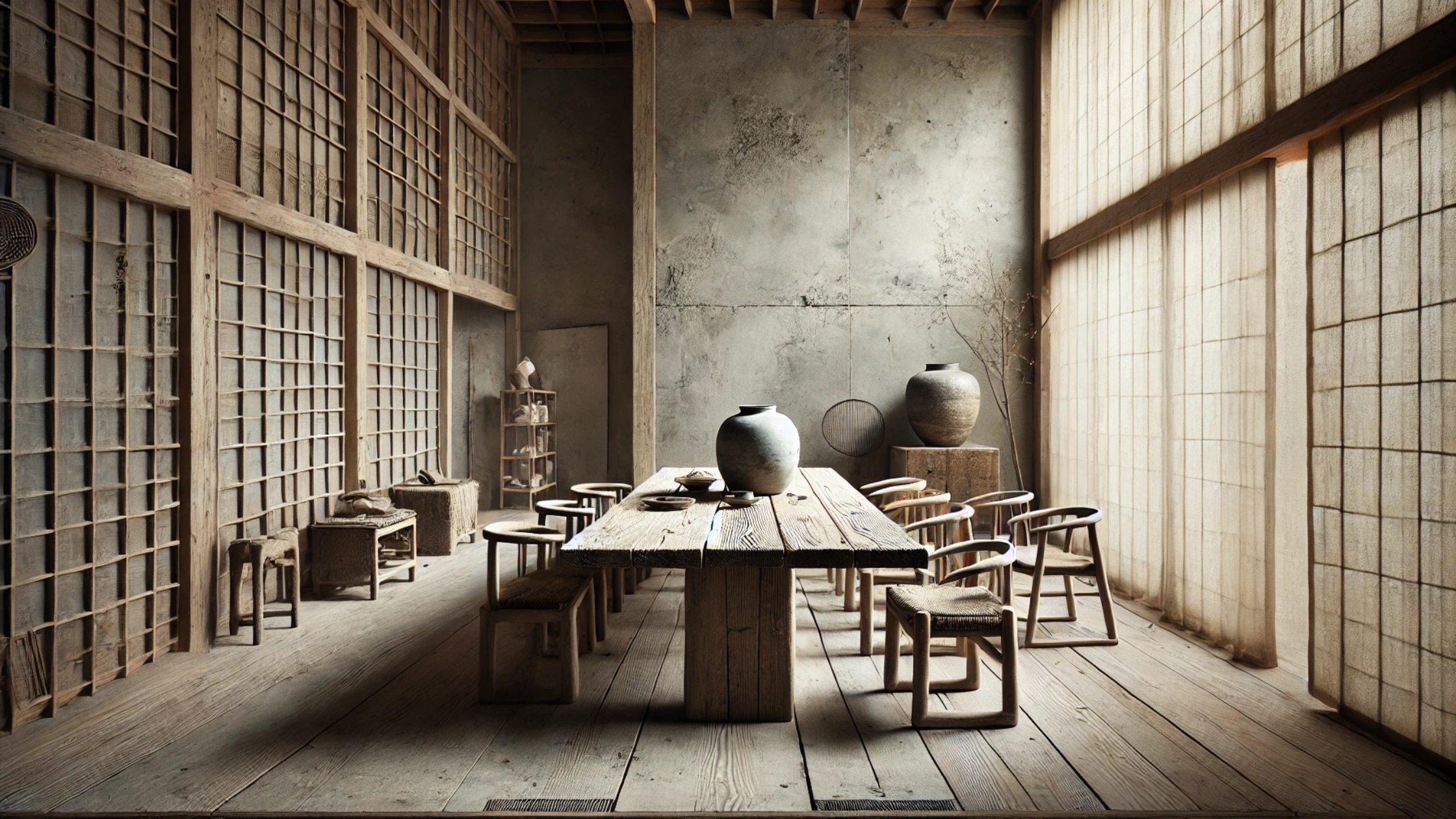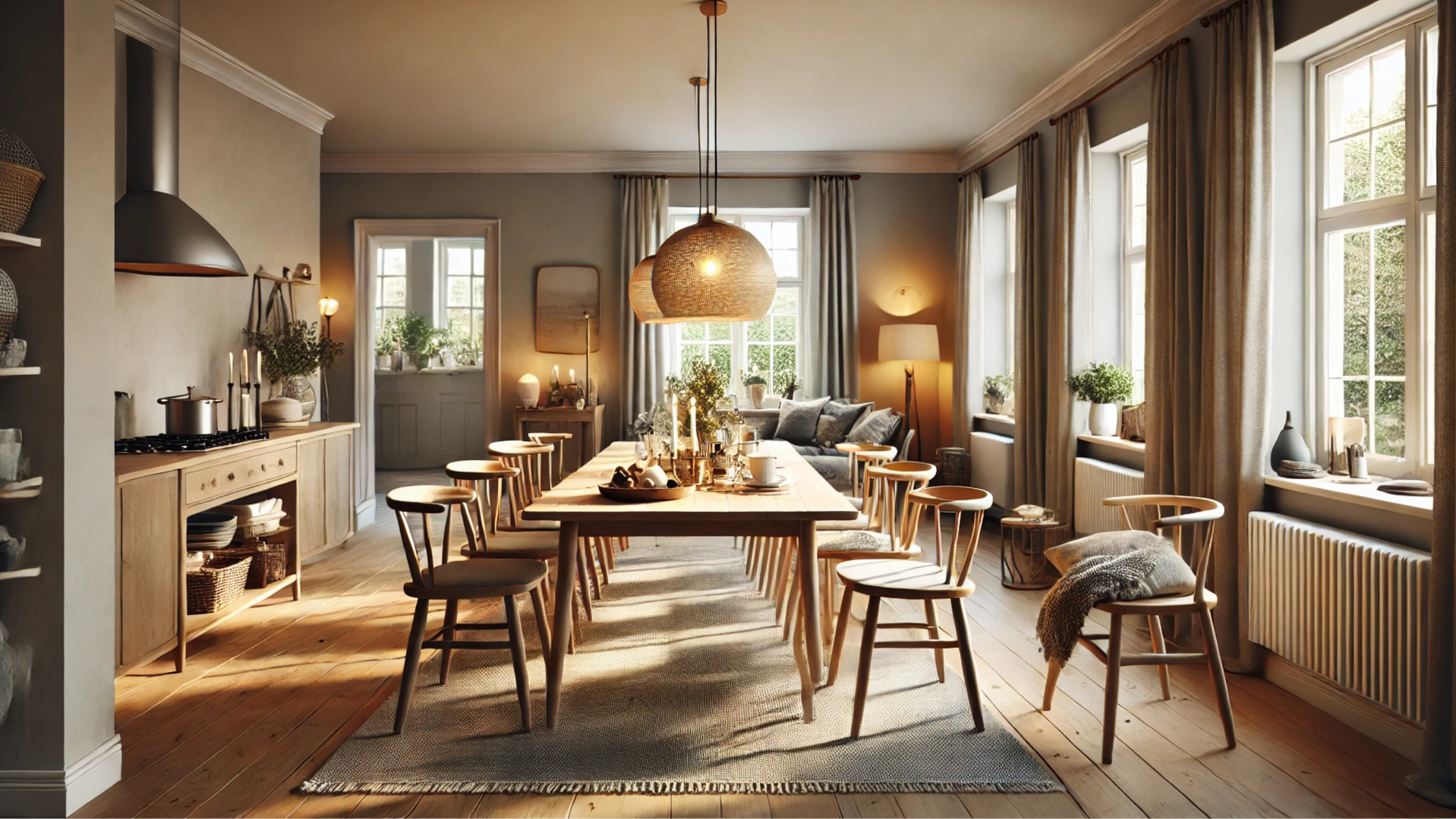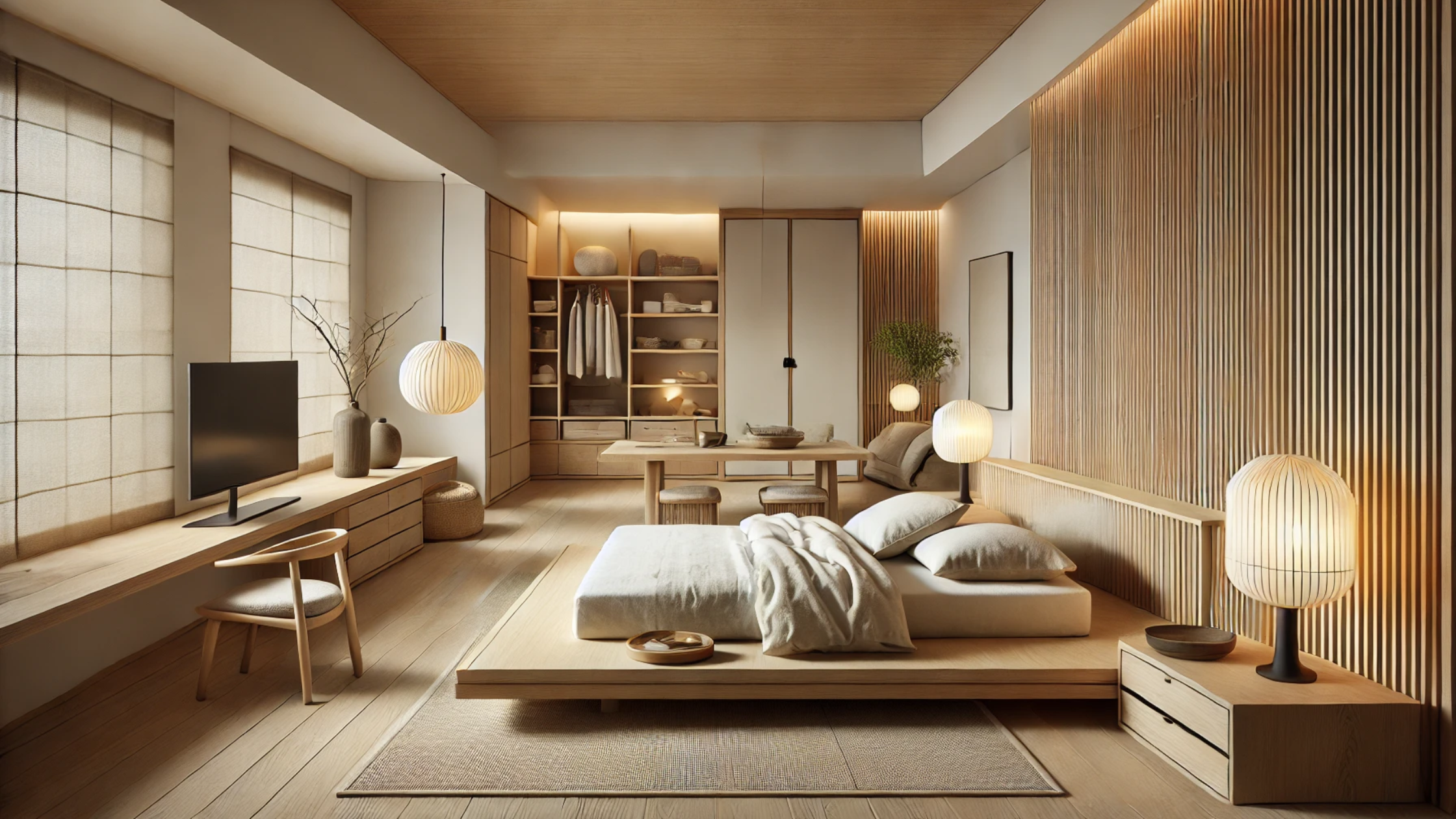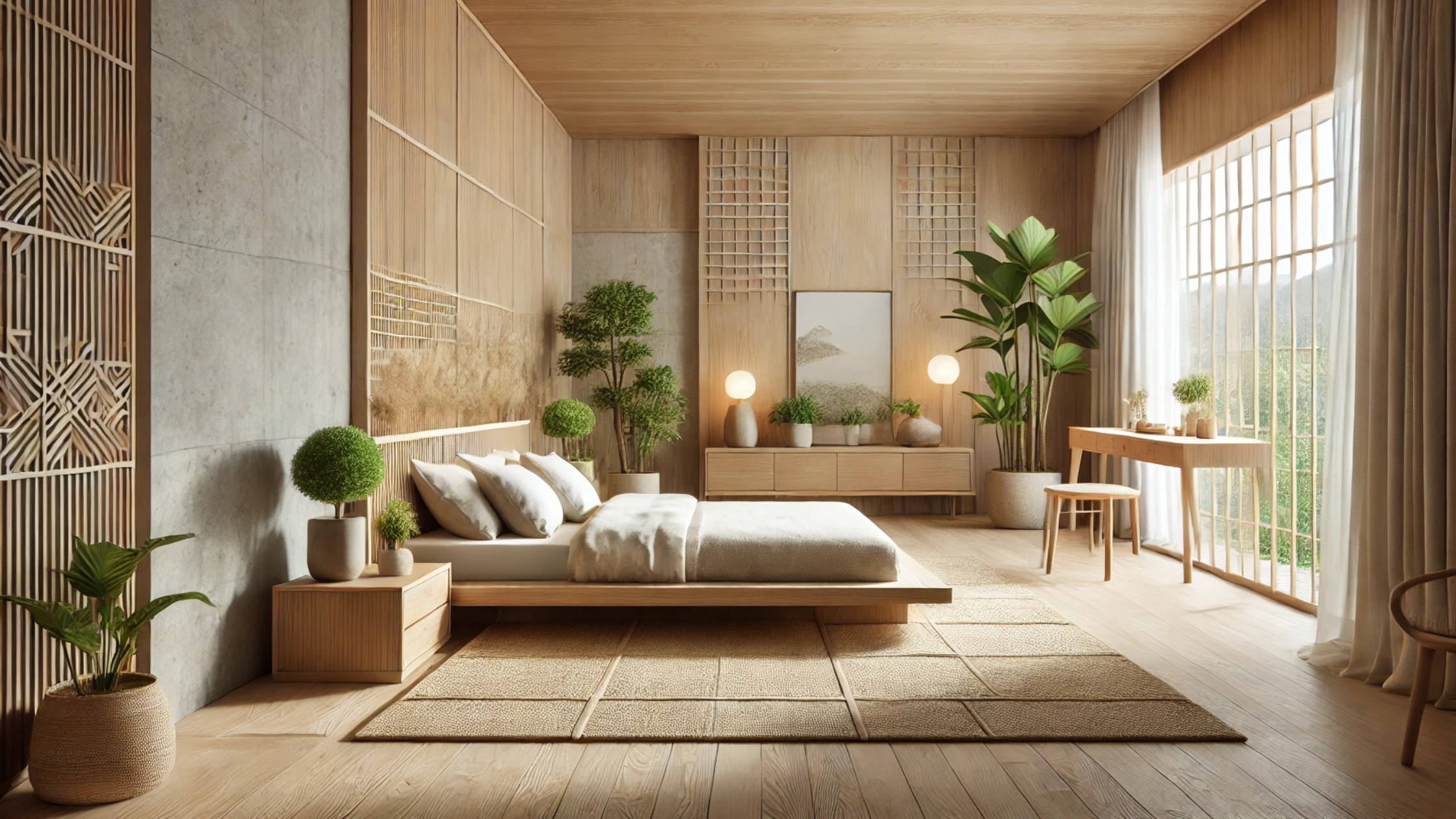Japandi Interior Design: The Fusion of Japanese Minimalism and Scandinavian Cosiness
Japandi interior design is a harmonious blend of two distinct yet complementary design philosophies: Japanese minimalism and Scandinavian cosiness. This style marries the sleek, clean lines and uncluttered spaces typical of Japanese design with the warm, inviting, and functional elements of Scandinavian interiors.
The Philosophy Behind Japandi Style
Japanese Wabi-Sabi: Embracing Imperfection and Simplicity
Wabi-Sabi is a traditional Japanese aesthetic that finds beauty in imperfection, impermanence, and the incomplete. It emphasises natural processes, simplicity, and the passage of time. The philosophy encourages an appreciation for the understated and the authentic, focusing on the intrinsic value and unique character of objects and spaces.
Japanese Minimalist Interior Design
Simplicity: The emphasis on simplicity in Japanese design means that Japandi interiors avoid excessive decoration and focus on essential, high-quality pieces. This minimalism creates a sense of calm and order.
Serenity and Mindfulness: By incorporating elements of Zen philosophy, Japandi interiors promote a tranquil environment that encourages mindfulness and relaxation.
Scandinavian Hygge: Creating Warmth and Comfort
Hygge is a Danish concept that embodies cosiness, comfort, and a sense of well-being. It is about creating a warm, inviting atmosphere that fosters contentment and conviviality. Hygge focuses on simple pleasures and the joy found in everyday moments.
Scandinavian Interior Design
Warmth and Comfort: The Scandinavian influence ensures that Japandi interiors are not only beautiful but also welcoming and comfortable. Soft textiles, warm lighting, and cosy nooks are all integral to this style.
Practicality: Scandinavian design’s focus on practicality means that Japandi interiors are highly functional. Spaces are designed to be lived in, with an emphasis on ease of use and everyday comfort.
Key Elements That Define Japandi Style
Minimalist Interior Design
Clean Lines and Uncluttered Spaces
Japandi interiors prioritise simplicity and functionality, with a focus on keeping spaces free from unnecessary clutter. Furniture and decor are chosen with intention, ensuring each piece serves a purpose.
Functional Furniture
Multi-purpose furniture is a hallmark of Japandi design, emphasising both form and function. Pieces are often streamlined and unadorned, contributing to a sense of order and calm.
Natural Materials
Wood and Stone
Both Japanese and Scandinavian designs make extensive use of natural materials. Wood, particularly light woods like oak and birch, is commonly used for furniture and flooring. Stone is often incorporated in countertops, backsplashes, and accent pieces.
Natural Fibres
Textiles made from natural fibres, such as cotton, linen, and wool, are prevalent in Japandi interiors. These materials add warmth and texture without overwhelming the minimalist aesthetic.
Neutral and Earthy Colour Palettes
Neutral Tones
The colour scheme in Japandi design typically includes neutral tones like white, beige, and grey. These colours create a serene backdrop that enhances the feeling of spaciousness and tranquillity.
Earthy Accents
To add depth and interest, Japandi interiors often incorporate earthy colours such as muted greens, browns, and terracotta. These colours evoke a connection to nature and add warmth to the space.
Integration of Nature
Indoor Plants
Incorporating plants is essential in Japandi design. They bring life and colour into the space, improving air quality and creating a sense of calm.
Natural Light
Maximising natural light is crucial. Large windows, minimal window treatments, and strategically placed mirrors help to reflect and enhance the natural light, making the space feel brighter and more open.
Balance of Form and Function
Harmonious Design
Japandi design strives to balance aesthetics with practicality. Every element in the space should contribute to both the visual appeal and the functionality of the home.
Mindful Arrangement
The layout of a Japandi interior is carefully considered to ensure flow and ease of movement. Furniture is arranged to promote interaction and accessibility, without compromising on style.
Designing Your Space with Japandi Style
Start with a Clean Slate
Remove all items from the room you’re redesigning. Sort through belongings, keeping only items that are necessary or bring you joy. Donate, sell, or discard items that no longer serve a purpose or fit the Japandi aesthetic.
Organise and Store
Use storage solutions like minimalist shelves, cabinets, and baskets to keep clutter out of sight. Opt for built-in storage to maintain clean lines and an uncluttered look. Keep surfaces clear, only displaying a few carefully chosen decor pieces.
Functional Furniture
Select furniture pieces that are both practical and aesthetically pleasing. Look for items with clean lines, neutral colours, and natural materials like wood and metal. Choose multi-functional furniture, such as a coffee table with storage or a sofa bed.
Minimalist Decor
Limit the number of decor items to avoid clutter. Use simple, handcrafted pieces that add character without overwhelming the space. Incorporate items that reflect both Japanese and Scandinavian aesthetics, such as ceramic vases, woven baskets, and wooden sculptures.
Natural Materials
Use wood, stone, and natural fibres throughout your space. Opt for wooden furniture, stone countertops, and natural fibre rugs and textiles. Choose sustainably sourced materials to align with the eco-friendly principles of both design philosophies.
Indoor Plants
Add greenery with indoor plants like bonsai, ferns, or succulents. Use simple, minimalist planters that complement the Japandi aesthetic. Arrange plants to enhance natural light and create a calming atmosphere.
Harmonious Design
Ensure that each element in the space serves a purpose while contributing to the overall aesthetic. Prioritise comfort and practicality without sacrificing style. Maintain a balance between empty spaces and thoughtfully placed furniture and décor.
Japandi Style for Living Rooms
Creating a Cosy and Minimalist Gathering Space
To achieve a cosy and minimalist gathering space in your living room, start with the seating arrangements. Choose a comfortable sofa with clean lines and neutral upholstery, embodying the minimalist aesthetic. Complement the sofa with accent chairs or floor cushions to provide additional seating, arranging them in a way that encourages conversation and interaction. For functional furniture, opt for a simple coffee table made from natural wood or stone, adding a touch of organic warmth to the space. Incorporate storage solutions like a media console or shelving unit to keep the room organised and clutter-free. A minimalist rug can help define the seating area and add warmth.
Japandi Style for Bedrooms
Fostering Tranquillity and Relaxation
In the bedroom, focus on fostering tranquillity and relaxation through thoughtful design choices. Begin with the bed and bedding by selecting a low-profile, platform bed with a simple headboard. Use high-quality, natural fibre bedding in neutral or earthy tones to promote comfort and restfulness. Enhance the cosiness by adding a throw blanket and a few soft pillows. When it comes to furniture, include a minimalist nightstand with clean lines and a simple design. A dresser or wardrobe made from natural wood provides practical storage while maintaining the room’s aesthetic. Keep surfaces clear, displaying only essential items like a lamp and a small plant to avoid clutter. For calming decor, opt for soft, ambient lighting, such as bedside lamps or wall sconces, to create a soothing atmosphere.
Japandi Style for Kitchens
Combining Functionality with Minimalist Beauty
In the kitchen, aim to combine functionality with minimalist beauty. Design the layout to maximise efficiency and ease of use, ensuring that all essential items are easily accessible. Use minimalist cabinetry with clean lines and neutral colours to create a streamlined look. Incorporate open shelving to display essential items and keep the space feeling open and airy. Choose countertops made from natural stone or wood to add warmth and texture. Wooden or metal utensils and accessories can enhance the natural aesthetic, while also being practical for everyday use. Opt for sustainable, eco-friendly materials whenever possible to align with the principles of Japandi design.
Japandi Style for Bathrooms
Spa-like Simplicity and Cleanliness
Transform your bathroom into a spa-like sanctuary by focusing on simplicity and cleanliness. Choose minimalist fixtures with clean lines and simple designs to create a sleek and modern look. Use a neutral colour palette with white, beige, or grey tiles and walls to enhance the sense of calm and spaciousness. A simple, frameless mirror can further the minimalist aesthetic while providing functionality. Incorporate natural materials like stone countertops and wooden accessories to add warmth and texture. Soft, natural textiles like cotton towels and linen shower curtains contribute to the overall sense of luxury and comfort.
The timelessness of Japandi comes from its core principles that prioritise quality over quantity, sustainability, and a deep connection to nature. These values are increasingly relevant in today’s world, where there is a growing awareness of the need for sustainable living and the benefits of creating a peaceful home environment. Japandi’s focus on natural materials and neutral palettes ensures that the style remains versatile and adaptable, able to evolve with changing trends while maintaining its foundational aesthetics.
Incorporating Japandi style into your home is not just about following a trend; it’s about adopting a lifestyle that values simplicity, mindfulness, and the intrinsic beauty of natural elements. Visit our website to learn more about utilising the best interior design for your home.
Frequently Asked Questions (FAQs)
What is Japandi interior design?
- Japandi interior design is a hybrid style that combines the minimalist, functional aesthetics of Japanese design with the warm, cosy elements of Scandinavian decor.
- This fusion creates a balanced, serene environment that emphasises simplicity, natural materials, and a neutral colour palette.
- The style aims to create spaces that are not only beautiful and modern but also practical and inviting, fostering a sense of peace and well-being.
How do I start incorporating Japandi style into my home?
- To begin incorporating Japandi style into your home, start by decluttering and simplifying your space. Remove unnecessary items and keep only those that are functional or bring you joy.
- Focus on choosing furniture with clean lines and neutral tones, made from natural materials like wood and stone. Introduce soft textiles such as woollen throws and cotton cushions to add warmth. Incorporate plants to bring a touch of nature indoors.
- Gradually, you can refine your decor by adding handcrafted, artisanal pieces that align with the minimalist yet cosy aesthetic of Japandi.
What are the key elements of Japandi interior design?
- The key elements of Japandi interior design include simplicity, functionality, and natural beauty. This style emphasises clean lines and uncluttered spaces, with each item serving a purpose.
- Natural materials such as wood, stone, and natural fibres are central to Japandi decor, creating a connection to nature. The colour palette is typically neutral, featuring shades of white, beige, grey, and earthy tones, which contribute to a calm and cohesive look.
- Additionally, the use of soft, ambient lighting and minimalist yet cosy furnishings are important to create a warm and inviting atmosphere.
How does Japandi style promote sustainability?
- Japandi style promotes sustainability through its emphasis on natural materials and quality over quantity. The preference for sustainably sourced wood, stone, and natural fibres aligns with eco-friendly practices.
- This design philosophy values longevity and timelessness, encouraging the use of durable, high-quality pieces that stand the test of time.
- By focusing on minimalism, Japandi reduces the need for excessive consumption and promotes mindful purchasing, contributing to a more sustainable lifestyle.
Can Japandi style be adapted to small spaces?
- Yes, Japandi style is particularly well-suited to small spaces. Its emphasis on minimalism and functionality helps to maximise space and create a sense of openness.
- By choosing multi-functional furniture and keeping decor simple, you can make a small area feel more spacious and organised. Light, neutral colours can also enhance the feeling of space, while natural elements and soft lighting add warmth and cosiness without overwhelming the room.
- The key is to maintain a balance between simplicity and comfort, ensuring that every piece serves a purpose.



















